Episode #417: Why Your Math Mentorship Model Isn’t Working — Insights from Jim Strachan
LISTEN NOW HERE…
WATCH NOW…
How do you know if your district’s mentoring and coaching efforts are actually making a difference?
Too often, system and instructional leaders focus on program delivery but miss the deeper question: how do we monitor and support the real impact of our math mentorship and coaching practices? In this episode, Jim Strachan returns to explore how leaders can center educator well-being, trust, and professional learning as essential foundations for student success. You’ll hear practical insights on how to navigate the complexity of school systems, avoid common blind spots, and create math mentoring relationships that build independence—not dependence.
In this conversation, you’ll learn:
- How to recognize whether math mentoring is building true capacity or just going through the motions
- What effective trust-building really looks like—and why it’s not a one-time thing
- A simple but powerful feedback strategy that gives math mentors honest insight into their impact
Press play to explore how you can better monitor and strengthen fluency in mentorship and leadership across your district.
Attention District Math Leaders:
Not sure what matters most when designing math improvement plans? Take this assessment and get a free customized report: https://makemathmoments.com/grow/
Ready to design your math improvement plan with guidance, support and using structure? Learn how to follow our 4 stage process. https://growyourmathprogram.com
Looking to supplement your curriculum with problem based lessons and units? Make Math Moments Problem Based Lessons & Units
Be Our Next Podcast Guest!
Join as an Interview Guest or on a Mentoring Moment Call
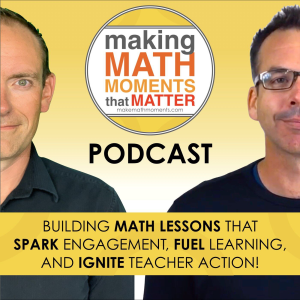
Apply to be a Featured Interview Guest
Book a Mentoring Moment Coaching Call
Are You an Official Math Moment Maker?
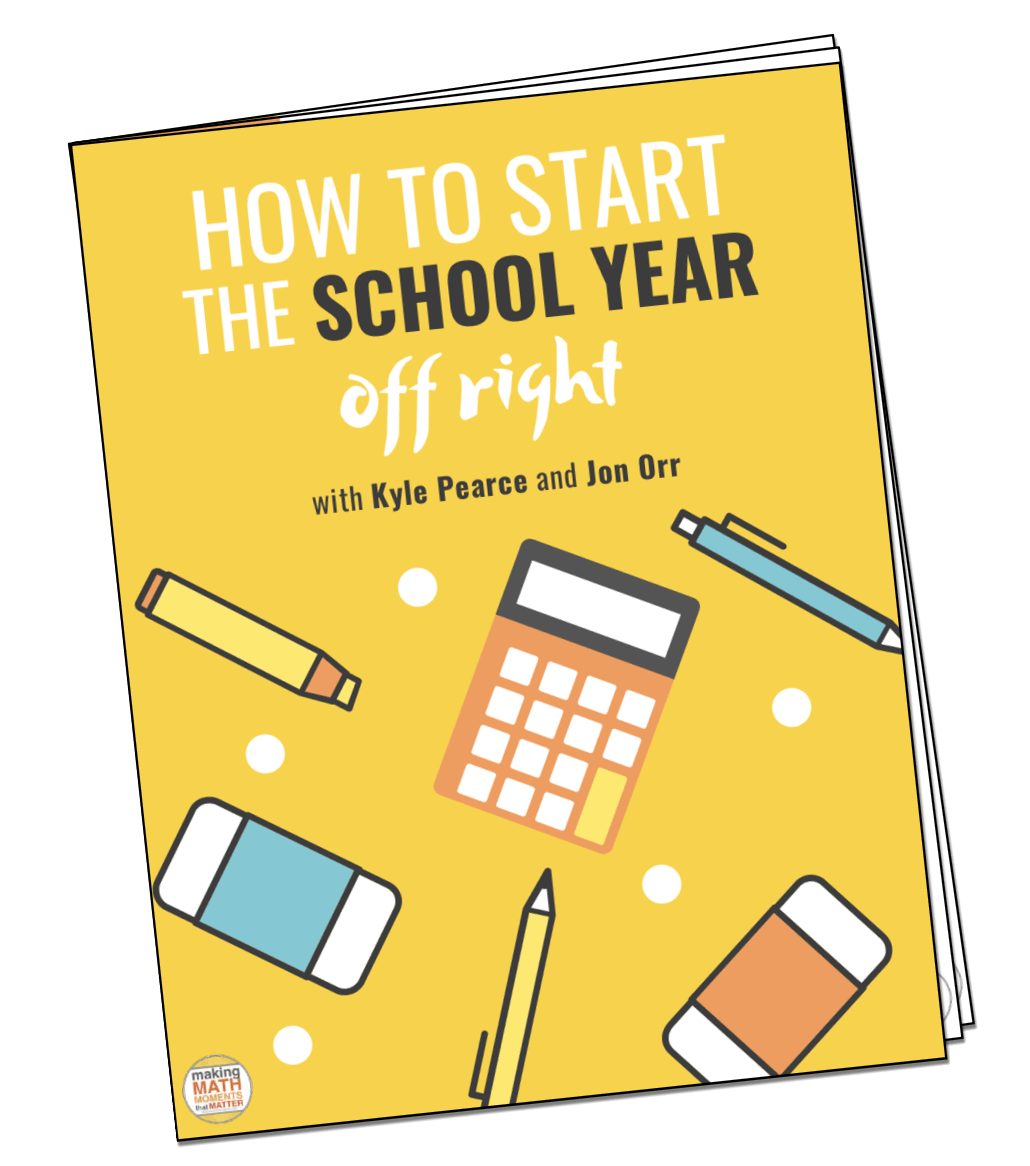
FULL TRANSCRIPT
Jon Orr: Hey there, Jim, welcome back to the Making Math Moments That Matter podcast. I was just looking up and I think it’s been a while because it’s been a few years since we’ve had you on, but I think it was like back in episode 200, like early 200s and now we’re talking about specifically episode like 418. So, you know, it’s been some time since we’ve connected specifically here on the podcast. So we’re excited to reconnect, share your message back with the MathMobileMaker audience. But before we do, like, how’s it going? know, and fill everybody in a little bit about where exactly you’re coming from.
Jim Strachan: Well, I’m coming from beautiful downtown Toronto on the shores of Lake Ontario, about two blocks south of the Rogers Centre where there’s this team playing not so well right now called the Blue Jays. And I am fortunate to live right by Lake Ontario. So it’s a tough life, John, but I hope somehow.
Kyle Pearce: Well, if folks remember from the last episode, which was a ways back, and I definitely encourage people to go back and check it out, you like to do a little paddle in the morning as well. So being on the shores, literally like right next to the shore is really helpful for you to get that paddle in, get your head straight for the day, and to potentially think about any pebbles that might be shaking or rattling around in your shoe or in your kayak. What sort of pebbles have you been kind of riffing on lately and let’s dig in here and get caught up?
Jim Strachan: That’s exactly why I kayak. The 26 years of exercise, good for my heart, I guess, physically, but good for my soul, just what you said, Kyle, the time to think, the day before, the day ahead. It’s been an exciting start to the year for me. I think there’s always a sense, despite whatever external circumstances people find themselves in, a sense of hope in the fall. of rejuvenation and reconnection in the cycle of the school year. And so I’m really privileged to be working in some places where the mentorship and coaching has really become part of the fabric of the work that the different school districts do. And I guess the pebble or the thing I continue to wonder about is how can we make educator learning and wellbeing be seen as a precondition for student learning and wellbeing? Because I don’t think you can do one without the other. And of course, there’s a reciprocal nature of those two factors. And so I guess that’s something that I’ve been thinking about and living in different contexts with different groups that I’m so privileged to work with.
Jon Orr: Right. Well, yeah, I think it is so important to think about that. And I guess it begs the question is that, you seeing that being a focus for school boards and school districts? know, like we talk with leaders in math programming, system leaders, school leaders, math coaches all the time. And you do as well. So. I got that just makes me curious. Like what is the state of that? You know, if we’re going to serve our kids and think about their well-being, we got to do that with the educators we’re working with. So do you feel like that’s a priority right now or is it just kind of like something that is a, hey, that’s a nice to have.
Jim Strachan: You know, I would say there’s so much variation. And I tend to find myself in places where that educator learning and wellbeing is being supported explicitly and in many ways. But to your point, John, I think our world is more complex. And so we shouldn’t be surprised that education and schools are more complex. So we can’t always influence those factors, but we can influence our 50%. So, and so most of the places that I work, I feel like the people who are working at a district level and beyond are very, very cognizant of the challenges educators face, but maybe not always as certain about what paths forward might bring the most promise. So I would guess that would echo some of the work that you both do in districts. I know it’s broader than just around math, but about designing professional learning that brings efficacy and empowerment to educators.
Kyle Pearce: Hmm. You know, it’s, so, so key. Like you said, a number of things there that, you know, had my wheels turning and ultimately at the end of the day, you know, this complexity and you had mentioned, you know, before we hit record about the idea of, you know, helping to navigate complexity, which, you know, again, some are a little more open to, and others I think can sort of, you know, maybe get a little anxious when they think about some of these things. And one of the, the biggest challenges I think we have as educators, we’re all educators, regardless of the role, if we’re in the classroom all the way up to the senior table, is this urgency. know, like there’s always this talk of urgency to try to help all students, but it’s almost, in my opinion, that urgency is what oftentimes actually holds us back from doing something, you know, effective or actually shifting or moving that needle is because we’re constantly trying to put out this what seems like fire, you know, this massive fire and we’re just dumping little buckets on this massive fire and you just run to a different part of the fire. How, when you’re working with any of the educators that you’re working with, be it leaders or teachers, how do you help people to maybe slow down a little bit and zoom out a little bit on that to get them feeling more confident that You know, the work we’re doing now, even though it’s going to be slow and thoughtful is actually the right work to be doing instead of this like rush to try to get to the fire and get it fixed or solved.
Jim Strachan: Yeah, so that word, those words, slowing down the pace. So that’s Lois Brown-Easton’s work from many years ago, that what effective professional learning does is slow down the pace. It brings students to the center of the learning. So the students, their student learning and wellbeing is the why of the learning. And it allows educators in whatever their role, time to reflect and to think about their current practice. And then most importantly, think about their now and their next and their end in terms of what are the implications. So I always think that the professional learning, whether it’s a formal sort of workshop or a community of practice or a learning series, those are just provocations. They’re important, but it’s what’s done with that learning. That’s really where the difference is made. And I think sometimes, and I only can speak for myself, and it always comes from good intention, we forget that we don’t know everything. Who knows the most about the learning in our schools? Well, our students, of course. They know the most, right? And who knows quite a bit? All those who surround those students, the parents, the community, the teachers, the school leaders. Who knows a little bit less? Somebody like me. I might know different things and that’s quoting Eleanor Newman who used to do something called student work study at the ministry. We might know different things than the classroom teacher, but we should never assume we know more. And so if we go into our learning with that stance that we’re going to be learning from and with, then the learning doesn’t feel done to educators. It feels like something they’ve collaboratively constructed. Just, I mean, deceptively simple, but deceptively complex. Everybody gets in, I think, to education with the best of intentions and the best of heart. But sometimes, through complexity and through many factors, we can get disconnected for that.
Jon Orr: for sure. I guess that immediately comes to mind, like when you think about getting into education, oftentimes know, systems, schools, we’re thinking about those new teachers and trying to make sure that they’re having the support that they need. you know, we talked specifically about mentoring and mentoring for all on our previous episode. And I know that that’s a big focus of the work is coaching and mentoring educators. I’m just thinking generally about how much time or how much focus we put on mentoring our early teachers. But then we kind of, that kind of fades as teachers become more, you know, they’ve got more experience, you know, they’re, veteran teachers. It’s, we all start to make, I think some assumptions down the road that’s like, well, we should be putting our emphasis on coaching new teachers and not necessarily our veteran teachers. And I guess I wanted to get your stance on, or not stance, but I just mean your opinions, your thoughts around like how important it is to, to kind of, kind of have a consistent focus of coaching and mentoring throughout a person’s. and not just say right at the beginning of their career and then saying, hey, that’s it.
Jim Strachan: Yeah, no, I couldn’t agree more, John. So I mean, so we do in Ontario have something called the New Teacher Induction Program that provides formalized mentorship and support. And I think it’s important because I think our new teachers are deciding, you who am I as an educator? What do I believe is important about teaching and learning? And how will I live those beliefs in my classroom? One of the things that’s powerful in the work we’ve done is we found that being a mentor helps stimulate the mentors own learning and growth. It makes them reflect more on their own practice. They feel more connected and they learn from the new teacher, the idea of the reciprocal nature. But yes, I think at every age, stage and phase of your career, you should have access to mentorship and coaching support and what it looks like might be different. And I know last time we talked about the web, but Who are the people that bring you strength, energy, passion and hope? They will be your true mentors. And sometimes that happens by accident, geography or friendship. We don’t necessarily need a formal program, but sometimes it doesn’t. often mentorship in education is associated with promotion. So I want to become a school leader. So there’s some mentorship or I’m a new school leader. But the question I always ask and that’s something that I think is kind of at the crux of what you’re saying is who mentors the mentors? So if we say those experienced colleagues are so important for the development and growth of their newer colleagues, well, who’s mentoring and supporting them? And that is quite a bit of my work, whether it’s working with teacher mentors or school and system leaders.
Kyle Pearce: I think we’re getting to the core of why we wanted to have you back on. And also one of the reasons we wanted to have you on the upcoming virtual summit is because this focus or your focus around mentorship and certainly, as we mentioned in the last episode, and I’m going to say it again, you’ve had the greatest impact on my understanding of what mentorship is and what the difference is between, you know, true mentorship versus say coaching and, you know, guiding and those types of things along the way. you’ve, you’ve really had me thinking differently and it had a huge impact on how I worked with other educators and, know, in your session at the summit, you know, you’re going to be obviously digging into this mentoring web and the idea of relational trust as we discussed in the, in the last episode and many other important features. And I think it’s really important for those who are listening, you’ll hear us often. And I would say probably more often talk about the importance of content knowledge. And recently on episode 407, we talked about ensuring that these leaders, these mentors are internalizing the objectives in math class specifically, but that there’s a second piece that’s so important. And internally in the… internalizing the objectives is helpful, but it’s not super helpful if we actually don’t have that leadership and coaching practice in place, like where people are actually able to be what Yvette called on that episode, like a bridge, right? Like to be able to like take those ideas and create a bridge to, you know, the next individual or the next group of individuals so that we can actually build that mentorship web. can you speak a little bit to your session that you’re coming up or that is coming up at the virtual summit and you know sort of give you know folks a little bit of a sneak peek. We obviously don’t want you to let all the you know the tricks out of the bag here but you know just give them a glimpse as to what you’ll be digging into in the session and what you’re hoping maybe someone would walk away with when they attend your session up at the November virtual summit.
Jim Strachan: Yeah, a bit of what you said. I think that there are in my experience, my lived experience, there’s some foundational elements to being a mentor. And so that’s really what we’ll explore. And as you mentioned, and we talked about last time, it does begin with trust. So what are the practical ways you can build trust in your mentoring relationships? Whether they be mentoring relationships with colleagues, with those who support, with students. And then once you’ve built trust, To be candid, just building trust isn’t enough. So once you’ve built trust, how can you have what I call learning focus conversations? Where you take your cue, and this is the work of my mentor, Bruce Wellman, you take your cue from the person and decide, is this an opportunity to be a consultant, a collaborator or a coach? So basing your stance and role on the needs of the person. And then we’ll dig into the complexity of feedback. So as a colleague, as a coach, as a leader, how do I provide feedback that’s respectful, meaningful, and growth-oriented? And we’ll explore three protocols that I find, at least finger quotes, actually useful. And then we have some work from the work in Ontario from the New Teacher Induction Program about what mentors do that seems to make the most difference. So we’ll look at some of what I call powerful mentoring designs. And my hope for the participants is in their context, in their real world, they’ll find some practical tools that they can use. And I’ll be very honest, a lot of the things that I’ll be talking about, people already do, it’s just bringing those things to what we call conscious competence, like letting people know the importance of these things and how they can be lived. And sometimes that’s just a reminder. And for some people, it is more of an open door to perhaps approaching things a little differently. So all that in 59.2 minutes or less, like there’s no pressure, right?
Jon Orr: Right, mm-hmm, yeah, exactly. Yeah, like we said, we’ll solve all the world’s problems here, but Jim, you’re about that, like what those moves would be, can you give a, you that you are gonna unpack all of those things in their session, but what’s one really important, say, move that you, you know, those power moves that you were really talking about, what mentors do, what would be one for sure to share today?
Jim Strachan: Well, I think the one that you guys are both very familiar with is this idea of appreciative inquiry. So I haven’t seen you, John, in a while. I would begin our conversation with, me the best thing that’s happened in the last 2.3 years since I saw you. Even if it was 2.3 days or 2.3 weeks. So you deliberately begin that mentoring conversation with a positive. Because often we look in the mirror and we don’t see the positives. We see all the challenges and the other things. And then asking a question eerily similar to what’s asked in the making math moments. What is that stone in your shoe? What is that issue or challenge? And that can be a tiny little pebble that you barely notice or it can be the size of your shoe. And then most powerfully, so how can we address that? So having a collaborative strategy harvest of ideas of things that we might consider moving forward. What I like about a piece of inquiry is it’s gentle, it’s aspect-based, but it also allows the person in an atmosphere of trust to be really honest and forthright about where they’d like to go and hopefully co-construct how they’d like to get there. So that’s one example of it.
Jon Orr: Yeah, no, those are good moves. Good moves for sure. Just the trust building and then also being able to be responsive to the pebble in your shoe or the winds. How important is that continued touch point? What I’m seeing right now in lot of other districts that we often meet with, especially for the first time, because we try to coach them away from this, but is the… I come, we come in or I only have time to meet with that teacher once and then there’s a cycle and it’s like weeks or months later before we get to back in that classroom. Like how important is it to be like those touch, like those multiple touch points in a row or multiple touch points where we’re dedicating time to building that trust, building that community with that individual teacher before jumping away and not seeing them for a while.
Jim Strachan: I think that early on in any sort of mentoring, coaching or professional learning relationship, it is important because the congruence between what you say and what you do builds trust. And then I think it’s funny as a mentor, because ultimately your goal is to sort of mentor yourself out of a job. So if I’m still touching base with you every 7.2 days a year from now, then I maybe really haven’t done a very good job of fostering your professional independence and vision. And so…
Kyle Pearce: Right. Or it’s become robotic, you know, where you’re actually not reflecting on the growth that may have happened.
Jim Strachan: Right. Or it’s Tuesday at 10 o’clock, so it’s time for me to do this. So I think that that idea, looking for ways to foster the positive independence and interdependence of the people that you’re working with, and over a time… So I went to two school boards last week, and I worked with people who are new to mentoring, who are going to be supporting new teachers. If I’m still driving to those school boards two years from now… I probably haven’t done a very good job with those teachers. On the other hand, I will go back to those school boards in a few months and we will do an appreciative inquiry because they’ll have begun their mentoring relationships and what’s working well, what are your stones, what are our next steps. So I think again, just like in teaching, varying our approach based on the needs of the people that we’re working with. And sometimes there is a need for those And those check-ins can really make a big difference because talking to somebody from outside can really be helpful. But sometimes maybe the world keeps spinning even if we don’t connect every 7.2 days because, know, just saying.
Kyle Pearce: Well, this is one of the pieces that can be difficult when we’re early in the process with the district improvement program clientele where they’re coming in and every district, every leader has a different starting point, a different place. There might take more time to build that trust, might take less time. Maybe they’ve already started an initiative and you’re coming in midway. And really what I’m hearing you say is like, really do have to take that time to slow down, to think and be intentional about the moves we’re making. And, you know, hopefully as we often say to the district improvement program, we say, you know, hopefully at some point you’re going to say, we don’t need this program, you know, we’re, we’re, we’re ready to kind of move on and, and be able to, you know, implement some of these ideas inside of their schools or districts. So.
Jim Strachan: And they know you’re there, right? So I’m privileged to be part of many, many mentoring relationships with many different organizations. And some I hear from once in a while, and some I don’t. And some I hear from fairly frequently. And so I think that’s, the complexity of teaching and learning. But that approach of building the capacity of the folks that you’re working with and learning from, that approach eventually leads to independence. And that is a goal, as it is for our learners.
Jon Orr: Mm hmm. Sure. Jim, what would you say? Like, there’s a lot of coaches and coordinators listening right now who who tended to tune into this particular podcast and and you know, what blind spots do you feel like a lot of us have in this role? It’s like this this hey, I’m doing such great work. I you know, we all think we’re doing great work. We all are doing great work. But there might be some blind spots. We just don’t know yet what we don’t know. having, you know, coached thousands of educators, you know, what are some of those blind spots we should be on the lookout for?
Jim Strachan: Yeah, that’s a great question. And two things come to mind, and I am privileged to work with a lot of, quote, board coaches or instructional leaders. The first is almost the reverse of that. Sometimes you don’t feel that you’re making a difference. You don’t see the difference that you’re making, especially if you’ve just come from the classroom. So, you know, in this crazy place called the classroom, we see every single day from our students the difference we are or we aren’t making. So sometimes the line back to the classroom is a little further removed. And so it wouldn’t be a blind spot per se, but thinking about how will you know that your work has had impact? Like what are some of the protocols that you could use? An example comes to mind, this was a few years ago, and these were a group of ESL coaches in a Southern Ontario school board. And what they did when they finished a time in the classroom, Instead of asking the teacher a scaling question, like one to 10, how was the lesson? They asked the teacher from one to 10, how helpful was my visit today in your classroom? a six. Well, tell me all the good things that made it a six. I’m coming back next Tuesday. How could we make it a seven? So finding ways to get feedback about your work. And then this isn’t specific to coaches, but the second one is, I think when we’re not in the classroom every day, we tend to forget how complex and messy learning is in the classroom. And that’s all, like that’s just to be expected. But I think spending time in classrooms, experiencing that complexity and messiness is probably one of the best pieces of learning that coaches can do. So it’s difficult to coach from behind a computer in the board office, although it might… There’s times you need to be behind the computer in the board office. And then guess really related to that, finding the oxygen in your role, finding the things that bring you strength, energy, passion and hope. And hopefully existing an environment which gives you the freedom to breathe that oxygen. Hashtag just saying.
Kyle Pearce: Hey, that’s, that is some great, you know, some takeaways here in it. You know, I think it’s really important for us all to think about it. You’d started that, you know, that, piece of, you know, and, and these ideas at the classroom level, this idea that you can see things changing from day to day. And it’s like, as we sort of get out of the classroom and it almost feels like we’re layers away, sometimes it can get really, really difficult to try to figure out how am I doing? You know, and I think it’s really important. I think your, your idea to sort of get a little pulse as to, you know, how, how the, the mentee is, is taking that relationship. How can I show up better for them so that we can try to work towards, you know, more of that outcome that we’re after. I think the other piece it does too, is it also helps to solidify that trust because you’ve asked them for some feedback and you’re starting to let them know that you know, I do care about, know, your opinion and your thought and that you have knowledge to bring to the table here as well. So that was, you know, sort of full circle for me. Many of the things that you discussed throughout this, the episode here, friends, as you’re listening to this episode, and I’m sure for those who will go back and listen to the original episode with Jim, you definitely want to check out his session coming up at the virtual session. It is called mentoring essentials. a session with Jim Strachan. So make sure that you go and check that one out because as we had mentioned, it’s really difficult for us to do this work and to do it well if we’re unable to have that lasting impact and to essentially spread your mentorship through that mentoring web. So Jim, I want to thank you so much for spending some time with us catching up. Hopefully it won’t be 2.3 more years before we do. Get connected here, but but go Blue Jays and hopefully hopefully when this airs They’re still in the playoffs and they haven’t you know, totally totally let this losing streak take advantage of things
Jim Strachan: thank you for having me. And by the way, if it’s longer, I’ll feel like I’ve done really well. I’ve mentored myself out of a job. So that’s, that’s good too.
Kyle Pearce: There it is. There it is.
Jon Orr: Thanks Jim. Take care.
Jim Strachan: Thanks.
Thanks For Listening
- Book a Math Mentoring Moment
- Apply to be a Featured Interview Guest
- Leave a note in the comment section below.
- Share this show on Twitter, or Facebook.
To help out the show:
- Leave an honest review on iTunes. Your ratings and reviews really help and we read each one.
- Subscribe on iTunes, Google Play, and Spotify.
DOWNLOAD THE 3 ACT MATH TASK TIP SHEET SO THEY RUN WITHOUT A HITCH!
Download the 2-page printable 3 Act Math Tip Sheet to ensure that you have the best start to your journey using 3 Act math Tasks to spark curiosity and fuel sense making in your math classroom!
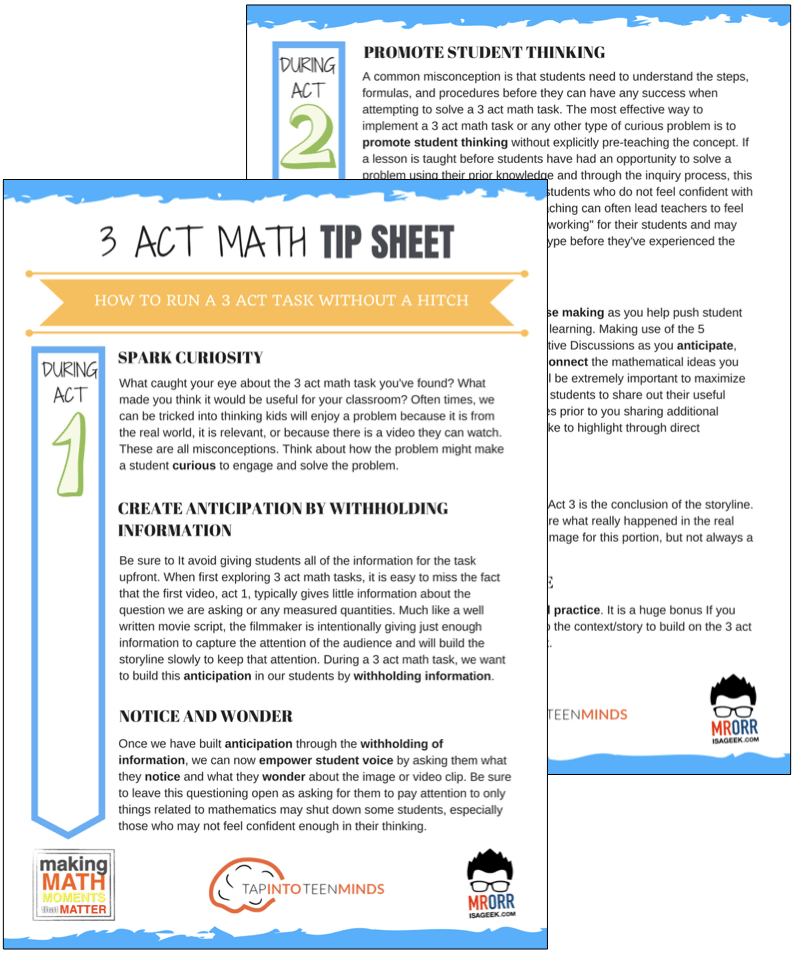
LESSONS TO MAKE MATH MOMENTS
Each lesson consists of:
Each Make Math Moments Problem Based Lesson consists of a Teacher Guide to lead you step-by-step through the planning process to ensure your lesson runs without a hitch!
Each Teacher Guide consists of:
- Intentionality of the lesson;
- A step-by-step walk through of each phase of the lesson;
- Visuals, animations, and videos unpacking big ideas, strategies, and models we intend to emerge during the lesson;
- Sample student approaches to assist in anticipating what your students might do;
- Resources and downloads including Keynote, Powerpoint, Media Files, and Teacher Guide printable PDF; and,
- Much more!
Each Make Math Moments Problem Based Lesson begins with a story, visual, video, or other method to Spark Curiosity through context.
Students will often Notice and Wonder before making an estimate to draw them in and invest in the problem.
After student voice has been heard and acknowledged, we will set students off on a Productive Struggle via a prompt related to the Spark context.
These prompts are given each lesson with the following conditions:
- No calculators are to be used; and,
- Students are to focus on how they can convince their math community that their solution is valid.
Students are left to engage in a productive struggle as the facilitator circulates to observe and engage in conversation as a means of assessing formatively.
The facilitator is instructed through the Teacher Guide on what specific strategies and models could be used to make connections and consolidate the learning from the lesson.
Often times, animations and walk through videos are provided in the Teacher Guide to assist with planning and delivering the consolidation.
A review image, video, or animation is provided as a conclusion to the task from the lesson.
While this might feel like a natural ending to the context students have been exploring, it is just the beginning as we look to leverage this context via extensions and additional lessons to dig deeper.
At the end of each lesson, consolidation prompts and/or extensions are crafted for students to purposefully practice and demonstrate their current understanding.
Facilitators are encouraged to collect these consolidation prompts as a means to engage in the assessment process and inform next moves for instruction.
In multi-day units of study, Math Talks are crafted to help build on the thinking from the previous day and build towards the next step in the developmental progression of the concept(s) we are exploring.
Each Math Talk is constructed as a string of related problems that build with intentionality to emerge specific big ideas, strategies, and mathematical models.
Make Math Moments Problem Based Lessons and Day 1 Teacher Guides are openly available for you to leverage and use with your students without becoming a Make Math Moments Academy Member.
Use our OPEN ACCESS multi-day problem based units!
Make Math Moments Problem Based Lessons and Day 1 Teacher Guides are openly available for you to leverage and use with your students without becoming a Make Math Moments Academy Member.
Partitive Division Resulting in a Fraction
Equivalence and Algebraic Substitution
Represent Categorical Data & Explore Mean
Downloadable resources including blackline masters, handouts, printable Tips Sheets, slide shows, and media files do require a Make Math Moments Academy Membership.
ONLINE WORKSHOP REGISTRATION
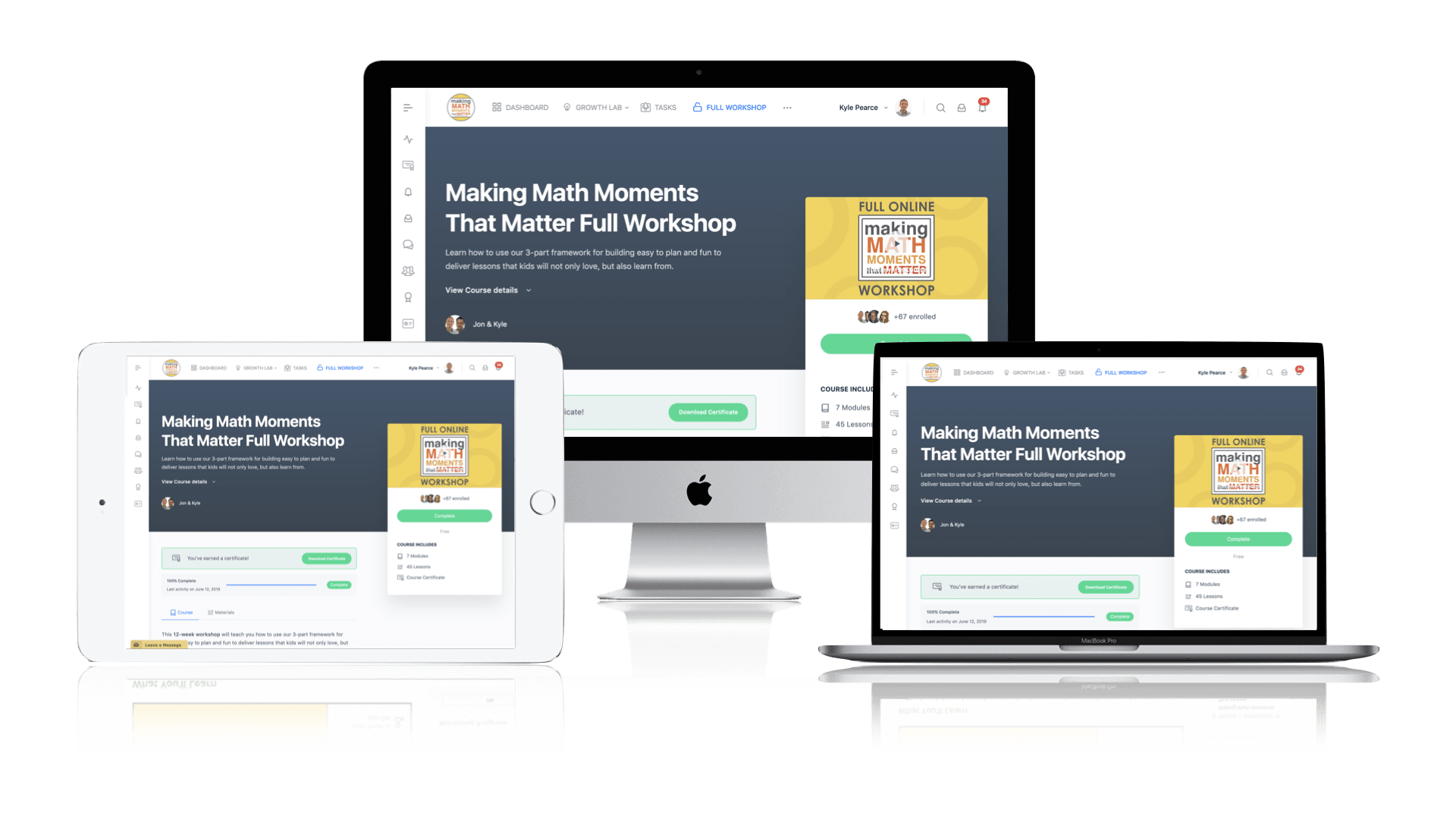
Pedagogically aligned for teachers of K through Grade 12 with content specific examples from Grades 3 through Grade 10.
In our self-paced, 12-week Online Workshop, you'll learn how to craft new and transform your current lessons to Spark Curiosity, Fuel Sense Making, and Ignite Your Teacher Moves to promote resilient problem solvers.
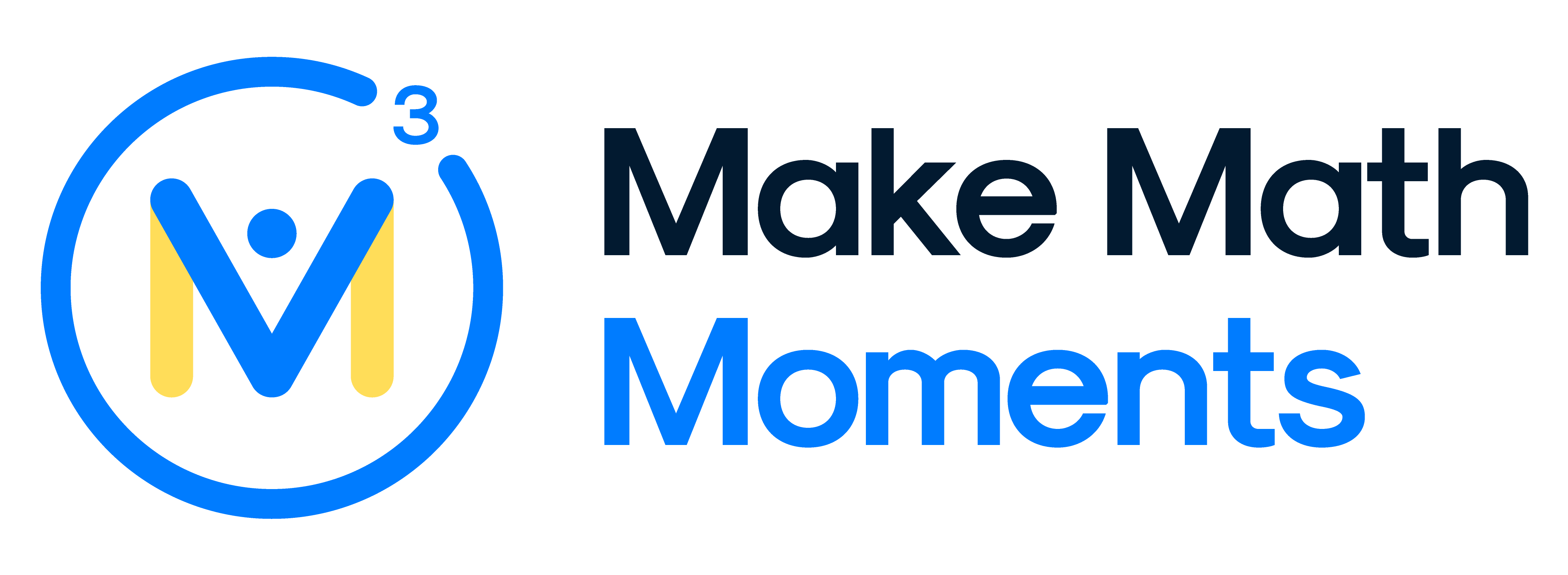



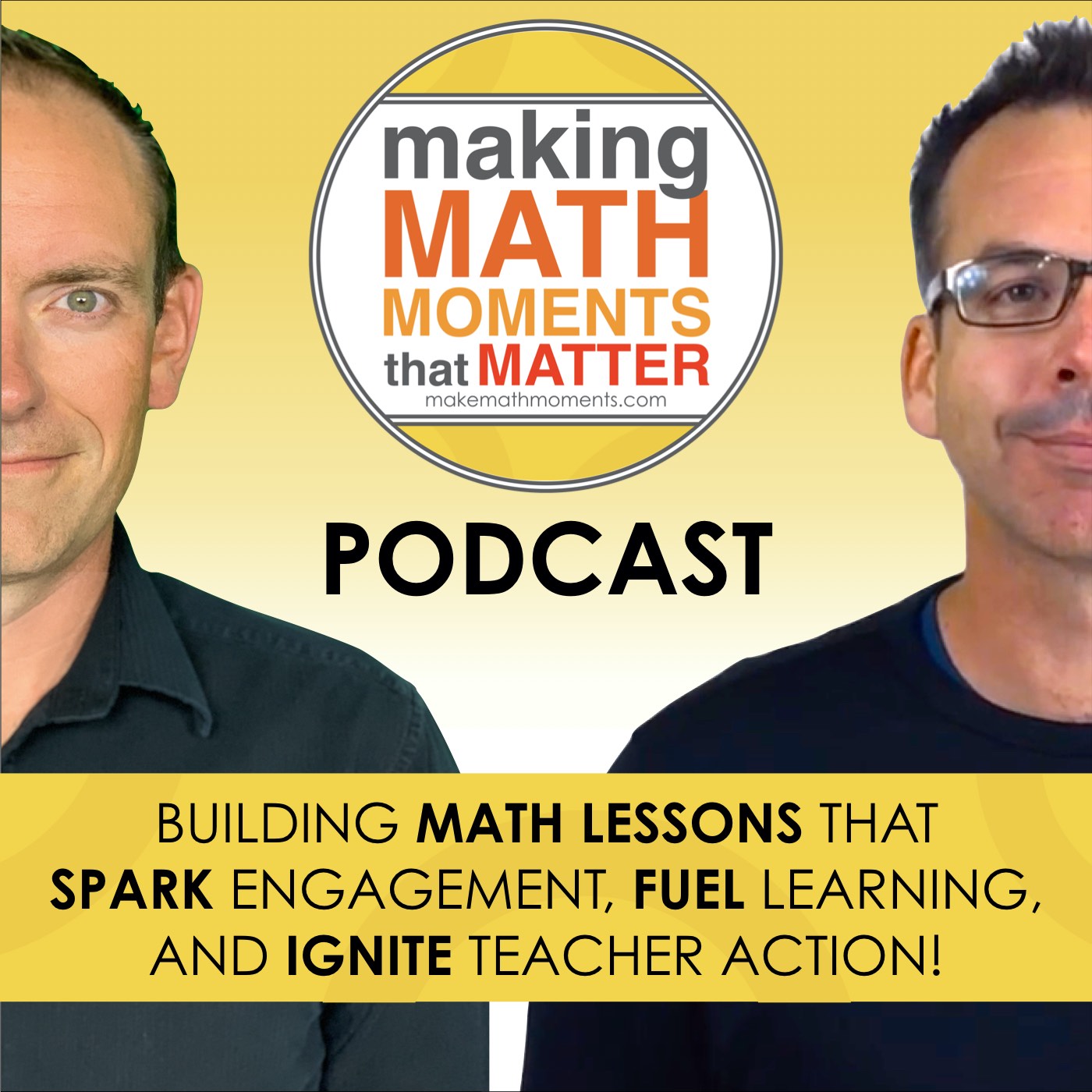
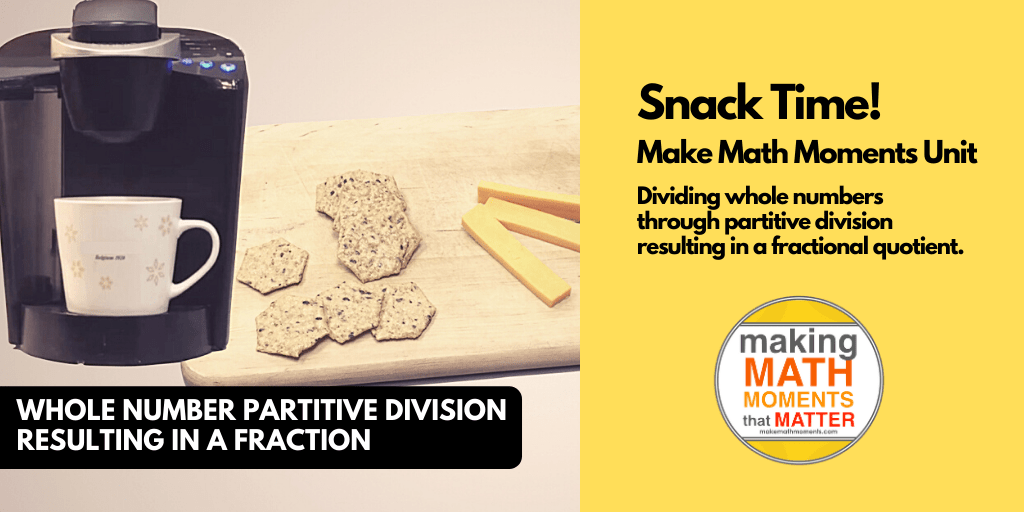
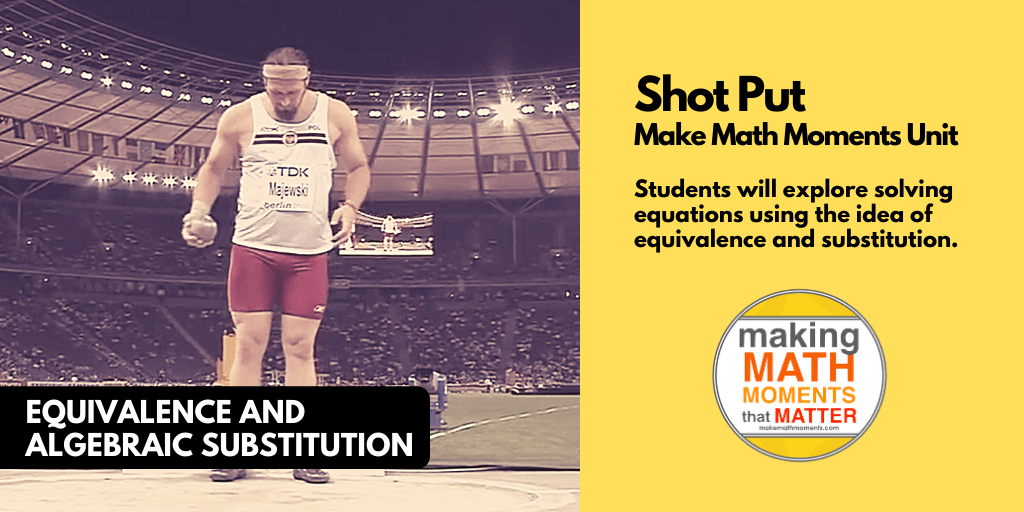
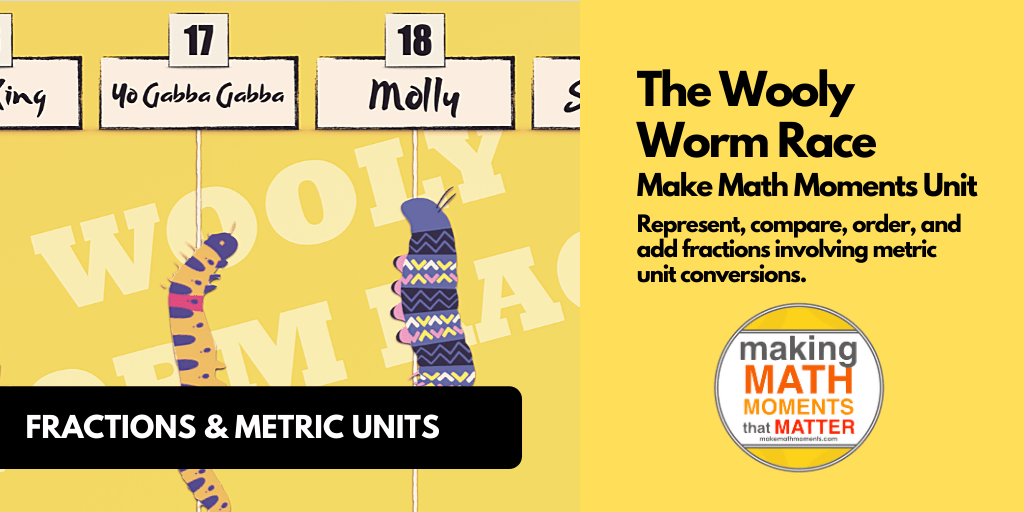
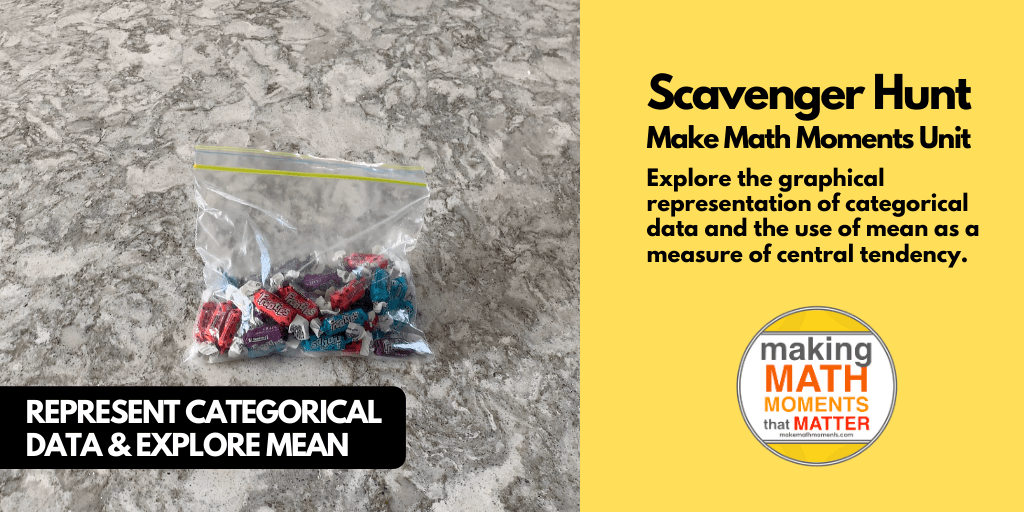
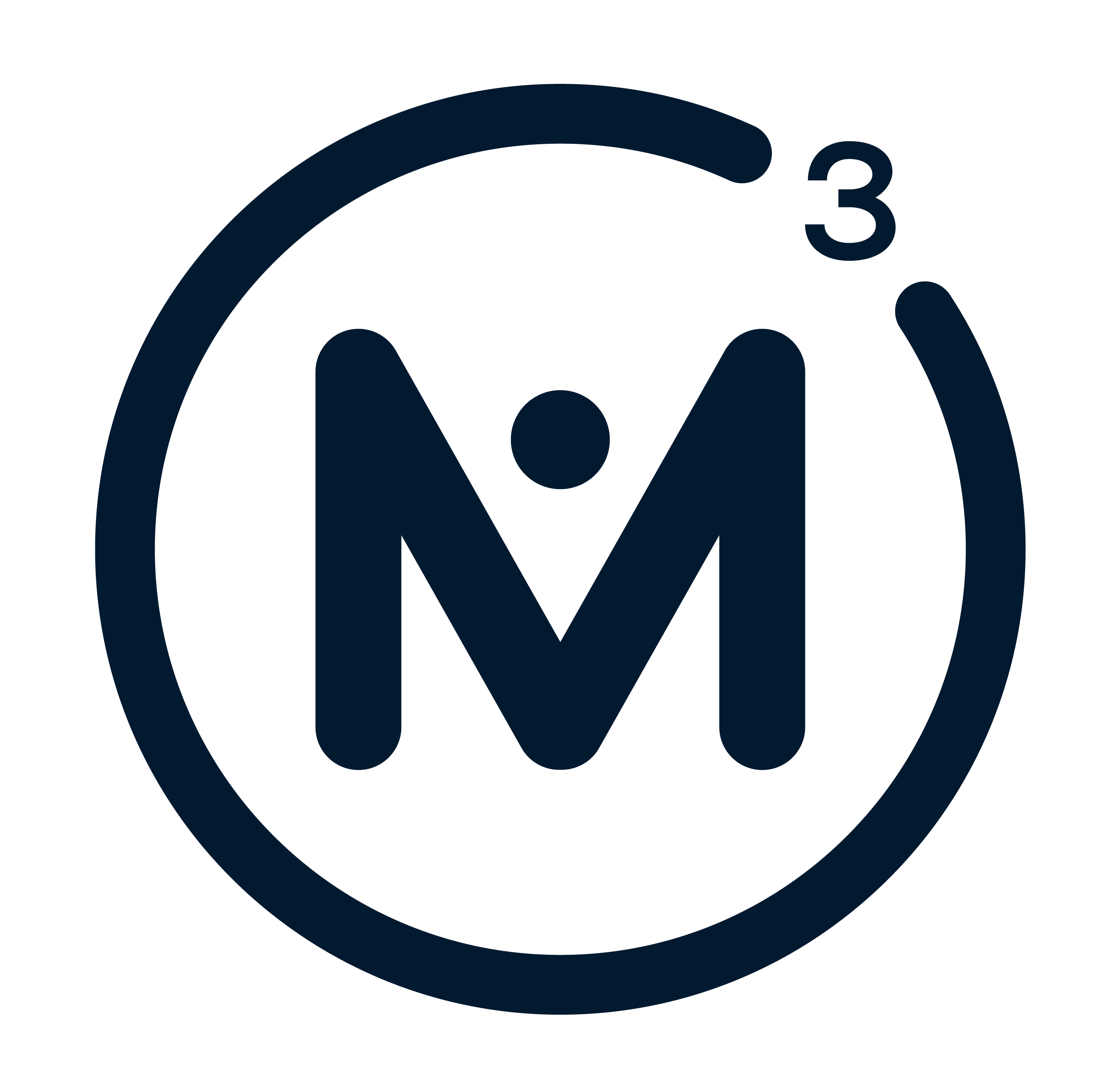
0 Comments